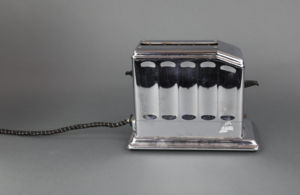September 10, 2018

Burnt toast doesn’t seem like a big deal, but if you had to eat it on a consistent basis you may feel otherwise. Humans have been eating bread for over 6,000 years and toasting it over a fire for just as long. Electricity was first introduced to American homes in the late 1800s. This generated demand for electric household appliances. The first electric toaster was invented in the 1890s. This device could only toast one side of a slice of bread at a time and needed to be monitored closely so that it didn’t burn the toast. Apparently, this happened frequently enough to inspire an invention that most people in the twenty-first century take for granted: the automatic pop-up toaster.
In 1919, Minneapolis resident Charles P. Strite was working at a manufacturing plant in Stillwater. According to Strite, the cafeteria often served burnt toast. This inspired him to create a toaster that would toast bread automatically with minimal human intervention. Strite’s device was called the Toastmaster and he was awarded a patent for it in 1921. The Toastmaster had heating elements that could toast both sides of a slice of bread at the same time. The device also had a timer that would turn off the heat and a spring that would eject the toast, eliminating the chance of burning. Strite’s invention found its way into restaurants immediately. By 1926, he introduced a consumer version with a variable timer that allowed the user to adjust the desired lightness or darkness of their toast.
The toaster in this photograph, one of three Toastmasters we have in our collection, was manufactured in 1931. It is a model 1A2 in chrome with a sleek art deco design. There are two Bakelite handles on either end of toaster with a fabric covered power cord extending from the back.
By 1930, more than one million toasters were being sold annually and by 1960 they had become ubiquitous in American kitchens. Today, a century since Charles Strite innovated the automated home appliance industry, toasters are still produced utilizing the same basic design. Although we may take perfectly toasted bread for granted, we should not forget that the inventor that allows us to do so was a resident of Hennepin County.
Written by Alyssa Thiede
This toaster was inventoried and cataloged as part of our larger collections inventory project. This publication was made possible in part by the people of Minnesota through a grant funded by an appropriation to the Minnesota Historical Society from the Minnesota Arts and Cultural Heritage Fund. Any views, findings, opinions, conclusions or recommendations expressed in this publication are those of the authors and do not necessarily represent those of the State of Minnesota, the Minnesota Historical Society, or the Minnesota Historic Resources Advisory Committee.


